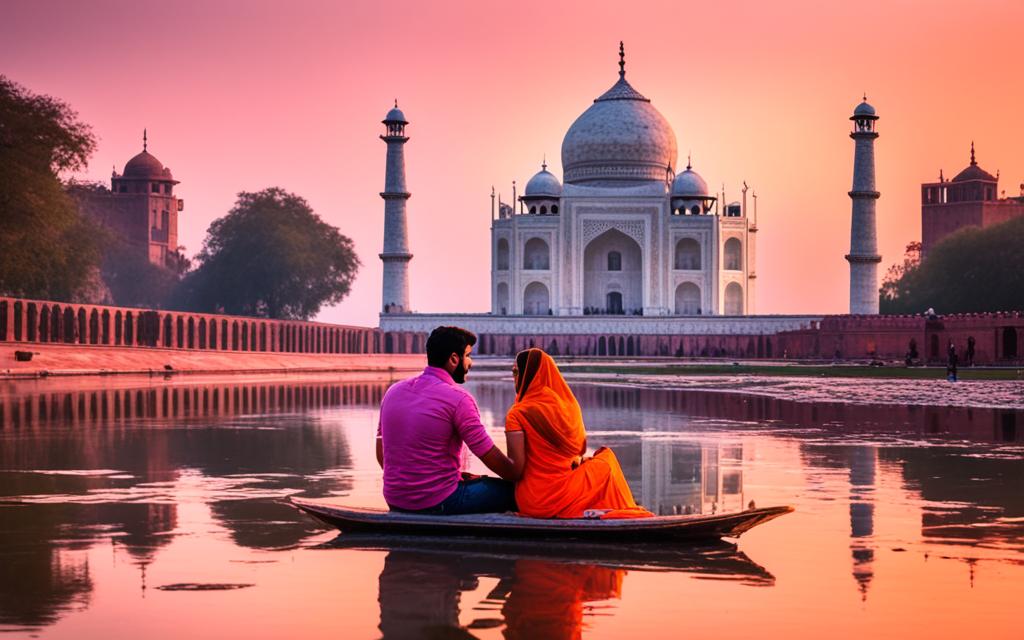The Taj Mahal shines bright in white marble, earning its title as a world wonder. Situated on the Yamuna River in Agra, India, it highlights everlasting love, Mughal architecture, and Indo-Islamic culture.
This legendary building has enchanted people for ages. Built in 1632 by Emperor Shah Jahan for his late wife, Mumtaz Mahal, it celebrates their love and showcases remarkable artistry.
Key Takeaways
- The Taj Mahal stands as a magnificent tribute in Agra, India. It was built by the Mughal emperor for his beloved wife.
- It is admired worldwide as a stunning example of Mughal art. It combines Persian, Islamic, and Indian styles.
- Recognized by UNESCO, the Taj Mahal is honored for its beauty and its global importance.
- Beyond its iconic form, the Taj includes lush gardens and a Moonlight Garden. These features add to its beauty.
- It remains a symbol of undying love and draws millions yearly. It offers a glimpse into the Mughal Empire and its rich history.
The Taj Mahal: A Marvel of Mughal Architecture
The Taj Mahal is a stunning building in Agra, India, blending Persian, Islamic, and Indian styles. It was ordered by Emperor Shah Jahan in 1632 as a tomb for his wife. This architectural wonder showcases the Mughal’s skill and love for detail.
Architectural Grandeur and Intricate Details
Made of white marble, the Taj Mahal boasts detailed carvings and inlaid gems. Its design represents perfect symmetry and harmony, complemented by lush Mughal gardens and the Yamuna River. These features combine to offer a serene and beautiful setting.
Symbolism and Meanings Behind the Design
The Taj Mahal is rich in symbolic value from the Mughal era. Its dome and minarets symbolize key aspects of the Islamic faith. The intricate writings and floral designs celebrate Mughal culture and Shah Jahan’s eternal love for Mumtaz Mahal.
The Timeless Love Story Behind the Taj Mahal
At the core of the Taj Mahal is a story of love and sacrifice. In 1632, the Mughal emperor, Shah Jahan, built it for his wife, Mumtaz Mahal. This act of eternal love marks the Taj Mahal as a symbol of forever love.
Shah Jahan’s Eternal Tribute to Mumtaz Mahal
The Taj Mahal represents Shah Jahan’s deep love for his wife. Mumtaz Mahal was more than his queen. She was his closest partner. The love they shared was beyond royal bounds.
The Heartbreaking Tale of Love and Loss
Mumtaz Mahal died in 1631, deeply affecting Shah Jahan. In her memory, he built the Taj Mahal, a timeless symbol of their love. This stunning monument is a lasting tribute to their love story.

Exploring the Taj Mahal: A Journey Through India’s Crown Jewel
Exploring the Taj Mahal takes you on an amazing trip. It’s one of the world’s top sights. Upon arrival, visitors are awestruck by its beauty. Located by the peaceful Yamuna River, it’s truly magnificent.
The area around the Taj Mahal is a model of Mughal gardens. These gardens are lush and look the same on both sides of the tomb. People can walk around and enjoy the beauty. It’s full of waterways and fountains, making it a calming spot.
As you get closer, the massive entrance to the Taj Mahal stands out. It’s the first glimpse of the wonder inside. Stepping through, you catch sight of the main attraction. The glowing white marble shines, decorated with fine designs and jewels.
“The Taj Mahal is not merely a monument, but a testament to the enduring power of human creativity and the timeless appeal of love.” – UNESCO
This journey lets you dive into the Taj Mahal‘s story. It helps you understand its place in culture and history better. You come to value this wonder more. It’s truly a beloved part of our world.
The Cultural and Historical Significance of the Taj Mahal
The Taj Mahal is a breathtaking example of Mughal architecture. It’s more than just a beautiful building. In 1983, it earned the title of a UNESCO World Heritage site. This recognition marks it as a symbol of global importance and beauty.
Influence on Mughal and Indo-Islamic Architecture
The Taj Mahal is a mix of Mughal architecture and Indo-Islamic design. It combines Persian, Islamic, and Indian styles. This harmony influenced later structures in Agra and the Indo-Islamic world. It showcases cultural sharing and creative achievement in the Mughal period.

The Taj Mahal: A Masterpiece of Mughal Gardens
The Taj Mahal is stunning not just for its white marble. Its Mughal gardens are also famous. These beautiful, symmetric gardens surround the mausoleum. They are a brilliant example of well-planned design.
The Serene Moonlight Garden
The Taj Mahal’s Moonlight Garden is especially captivating. This garden sits near the Yamuna River for a calm setting. It has beautiful paths, fountains, and plants that make it magical at night.
The Intricate Water Channels and Fountains
The water channels and fountains at the Taj Mahal are amazing works of engineering. They look gorgeous and help keep the garden’s climate right. The running water and soft mist set a relaxing mood that fits perfectly with the Taj Mahal’s beauty.
Conclusion: Preserving the Taj Mahal for Future Generations
The Taj Mahal is a symbol of timeless beauty and enduring love. It is one of the world’s most iconic landmarks. Every year, millions of people visit to see its stunning design and learn about the Mughal Empire.
As a UNESCO World Heritage site, protecting the Taj Mahal is vital for everyone. Ongoing efforts focus on its conservation and promoting sustainable tourism. This is key to keep inspiring people for years to come.
The Taj Mahal symbolizes eternal love across time and cultures. It showcases human creativity, devotion, and the search for beauty. Keeping this monument alive is a tribute to the Mughal heritage. It ensures the Taj Mahal’s extraordinary story and architectural value continue to impress and motivate visitors worldwide.




